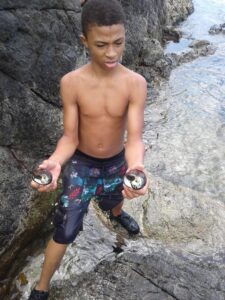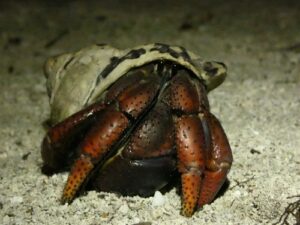
Recently, I had an email discussion with a friend about whelks, also called West Indian Topshell or Cittarium pica. During Carnival season on St. Thomas, she said to me that she “looks forward eating whelks.” Whelk is a cultural food item in the Virgin Islands and throughout the Caribbean region and the central coast of South America. In fact, eating of whelks goes back to the indigenous inhabitants of the West Indies archipelago. They lived off the islands’ abundance of sea life, such as fish, crustaceans, and mollusks, as well as from the island’s forests and wild native fruits and animals.

Who also depends on whelks, not for food but shelter? It is the soldier crab (hermit crab), Coenobita clypeatus. Every year in the Virgin Islands around August time, soldier crabs migrate to the shore for their annual ancient love-making ritual. After laying 1,000 to 50,000 eggs, they return to the upland forest. As the soldier crabs grow, they abandon their old shells and move into larger shells. In Japanese culture, they call soldier crabs “rent me a house” because they move out of a shell and into a new home.
It is for this reason and others that Virgin Islands Code prohibits the taking, catching, possessing, transporting, or exporting of indigenous species. The prohibition also incudes the removal of coral shells, sand, and other native species of flora and fauna. This also includes taking of whelk shells off our beaches. Solider crabs depend on whelk shells to use for a home. You might not be aware, but solider crabs are not born with shells. Terrestrial soldier crabs have a somewhat soft body, which is protected by a hard shell-like whelk.
For those who don’t know what a whelk looks like, whelks are large snails (marine gastropod) that you find in our coastal shallow rocky marine environment. Some grow to large sizes, such as 4 inches wide or more with a popular tasty flesh that locals like to eat. The shells are hard and heavy, equaling about three-fourths of a whelk’s weight. They can be easy to identify with a heavy black or purple stripe on a white background color. However, sometimes it might be hard to identify them because of algae growth on the shells.
Young whelks of about one-half-inch wide are common in our rocky coastal environment. They are mostly white shells with regular black spots. As they grow older, the white color changes as the black spots become larger and more zigzagged on the shell. You will find whelks in intertidal zone areas along rocky coasts. What this means is the shoreline that extends from the highest high tide down to the lowest level of waterline along the coast.

Whelk habitat in the coastal environment doesn’t extend very deep in the water. Most whelks, however, can be found immediately at the edge of the waterline. Adult whelks might occur slightly deeper, but they are generally not more than three feet below the waterline. They restricted themselves to the intertidal zone. They also like to eat thin strands of seaweed that grow on the intertidal rocks and filamentous algae. Whelks grow very slowly. However, if there is plenty of good food, their shell width increases about one 16th of an inch per month.
As a result of their slow growth, it could take whelks about five years or probably more to reach the size of reproductive adults. Although scientists believe the lifespan of whelks is about 30 years, they are still trying to figure out how long whelks can live. Whelks don’t move very far. Most of their movements take place at night when whelks’ activity is searching for food. Therefore, there are laws in place in the Virgin Islands and probably elsewhere in the Caribbean region where there is a season to harvest whelks.
For example, in the early 19th century, Bermuda’s whelk population was driven to extinction because of over-harvesting. This impacted the island fishing industry and impacted soldier crabs that depend to some extent on the shells of whelks. Laws were put in place and successfully Bermuda was able to revive its whelk industry. Believe me, depleting our resources like whelks can lead to culture extinction of a particular dish like whelk and rice or whelks with coconut sauce in the Virgin Islands.

Let me stop before your mouth becomes watery. I think we all get the message of protecting our natural resources to continue our cultural tradition of eating whelks in the Virgin Islands, especially during our cultural events. Let me ask this question to my reading audience: you heard the term “picking whelks?” Where do you think it comes from? It’s simple and it means traditionally in these islands and throughout the Caribbean that men and women roll up their pants to above their knees as they pick whelks along the coast. This is cultural.
Believe me, I love our Caribbean culture. We are such a unique people on the planet. Nevertheless, there are predators in the natural environment of whelks. There are three water snails that prey upon whelks. These predators are the mouthed rock shell (Puqura patula), rustic rock drill (Thais rustica), and the deltoid rock drill (Thais deltoidea). Fish like porcupine, puddingwife wrasses, octopuses, and birds like oystercatchers pluck whelks off the rocks. But the number one predator of whelks is humans.
I can never forget the time when the St. Croix Hiking Association members camped out at White Bay Camp in Jost van Dyke. We explored the rocks in White Bay Camp and harvested whelks. Well sir, we put a pot on a three stone fire and boiled the whelks for hours. When the whelks done boil, it would be a meal fit for a king under a full moon at the beach. I will never forget that experience. I will leave you with one of many traditional Virgin Islands recipes for whelks from our “Native Recipe Cookbook” from the UVI School of Agriculture.
Whelks & Rice
2 dozen whelks
½ pound rice
2 cups water
2 tablespoons butter
6 cups cooking ham (cubed)
1 medium sweet pepper (chopped)
1 medium onion (chopped)
1 clove garlic (chopped)
1 small can tomato sauce
1 sprig thyme
Boil whelks slightly. Remove from shell, discard tail ends. Cut into small pieces. Sauté ham, onion, sweet pepper, garlic and thyme in butter. Add tomato sauce and water. Add whelks. Cook for 10 minutes. Add rice and continue cooking on medium heat for 15 to 20 minutes or until rice is cooked.
— Olasee Davis is a bush professor who lectures and writes about the culture, history, ecology and environment of the Virgin Islands when he is not leading hiking tours of the wild places and spaces of St. Croix and beyond.





